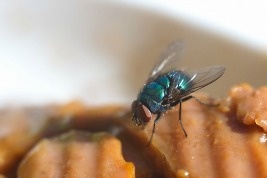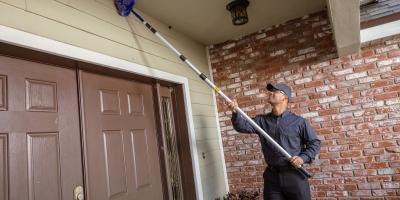Fly Control For Your Business: 5 Simple Steps To Control Flies

The following is an excerpt from our new e-book, Keeping Flies Under Control In Your Business.
1. Exclusion
A fly infestation is far less likely when there are no easy access points for them to enter. Ensure that all doors and windows close properly and tightly. Weather stripping is recommended for any exterior openings. Repair all holes and tears in window screens. Locate any unsealed crevices or cracks that lead outside of your building and seal them with a silicone-based caulk. Create a positive airflow draft that directs air outside of your building. This way, smaller airborne flies will have difficulty entering your business. Make sure that your employees remember to close all doors and windows, especially those adjacent to lights.
2. Inspection
Inspect the perimeter of your building and search for any feeding or breeding locations. A common female house fly can lay approximately 500 eggs in three to four weeks, so identifying possible breeding areas is critical to the prevention process. Thoroughly investigate any wet or moist areas, since flies need water to survive and reproduce. Check for larvae or maggots on any materials received from vendor shipments. Eliminate any other possible attractants from the premises.
3. Sanitation
Regular trash removal and sanitation will also help minimize the risk of unwanted flies. Clean any garbage collection sites that may have accumulated debris or waste. Cycle produce stock often to dispose of moist or rotting material. Place any exterior trash receptacles as far away from the building as possible. Repair leaking drainage lines, which can also attract fruit flies and phorid flies. Since flies are usually attracted to odors, it is important to sanitize areas that contain pungent-smelling bacteria. Note that many flies are attracted to nitrogen and ammonia, since rotting organic materials will often contain these substances. Therefore, is it imperative that you choose your cleaning materials wisely, and eliminate odors; don’t simply mask them.
4. Control
Wall-mounted insect light traps (also known as ILTs) are highly recommended by pest professionals to keep fly populations in check. Flies and other insects are attracted to specific wavelengths of light, which are emitted by ILTs to lure unwanted pests and eliminate them swiftly. When used efficiently, ILTs are placed in strategic locations to ensure that the light trap will be the first light source that intruding insects will see. Your pest professional will work with you to determine the best locations to place ILTs, keeping in mind customer traffic and low visibility areas. Fly traps are sometimes used as a supplement to your IPM solution in locations where electricity is unavailable or where ILTs would otherwise be impossible or inappropriate.
It’s crucial to understand which control methods are suitable for your business type. For example, insecticide or chemical treatments can be dangerous, and not appropriate to use around food or other customer-handled goods. Chemical treatments should be applied only by licensed pest management professionals, and should be considered only if all other pest management methods have been unsuccessful.
5. Educate Employees
Teach your team about IPM solutions, and encourage them to practice sanitation and prevention techniques. Even in an office environment, employees may unwittingly contribute to pest problems by leaving their afternoon snack on their desk overnight or not cleaning their dishes in the office kitchen. Remove garbage and sanitize break rooms whenever possible.
No matter how big or small your fly problem might be, flies can always be a threat to your business. Fortunately, there are many possible solutions to eradicating a fly infestation, and by implementing a solid Integrated Pest Management system, you can reduce the risk of flies significantly.
Have questions about keeping flies out of your business? Contact JP Pest Services today for a free fly control consultation. Our service professionals understand the specific requirements to keep New England businesses not only fly-free, but pest-free.



